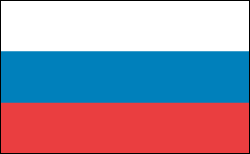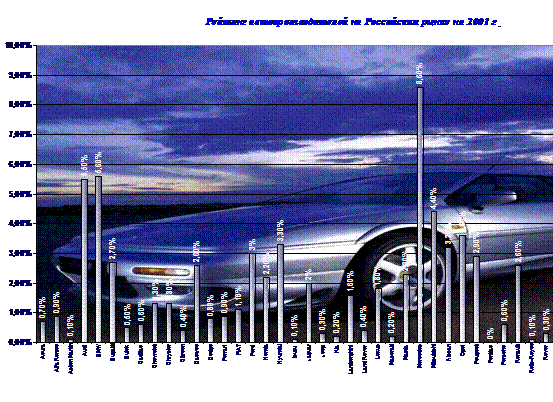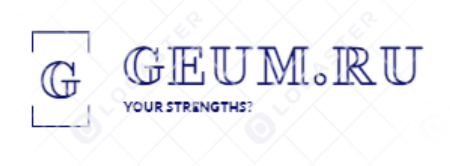Kompaniya Tata na Rossiyskom rynke avtomobilestroeniya v perspektive
Understanding Global Markets

Tata Motors - the best to the masses
TataТs Entry Into
Russian Automobile Market

Prepared by:
Rashid Mukhamedov
Prepared for :
Eliana Senna
MAIBA January 2006
May 25thа 2006
Bournemouth University
Contents :
Introduction ..2
Market opportunities for Tata in Russia4
Macro-environment ..5
CountryТs pest analysis5
Political factors5
Economical factors.5
Socio-cultural factors.6
Technological factors.7
Industry
factorsа Direct competitors and rivalry among existing
companies...7 Micro-environment
...8 Swot
analysis..8 Strengthsа
Opportunities and threats..8-9 Market
entry mode9 Market
segments.9 Marketing
mix.10 Product...10 Price..11 Place 11 Promotion...11 Conclusion12 References
13 Introduction УTata - the best to the MassФ Today Tata is IndiaТs
biggest car manufacturer with a 59% market chare.Established inа 1945 Tata Motors, is one of India's largest
automobile makers, has been manufacturing buses, commercial trucks and
tractor-trailers, passenger cars (Indica V2, Indigo, and Indigo Marina), light
commercial vehicles (TATA 407), and utility vehicles (Tata Safari EX+, Tata
Sumo SE+, Tata Spacio) for sale primarily in India but also in other Asian
countries and in Africa, Australia, Europe, the Middle East, and South America.
With such a large export presence, the company operates plants in Bangladesh, Kenya,
Malaysia, South Africa, and Ukraine. Tata Finance, in which
Tata Motors held a 12% stake, has merged with Tata Motors. Tata Motors, a
Company that cares about the future. True to the tradition of the Tata Group,
Tata Motors is committed in letter and spirit to Corporate Social
Responsibility. It is a signatory to the United Nations Global Compact, and is
engaged in community and social initiatives on labour and environment standards
in compliance with the principles of the Global Compact. In accordance with
this, it plays an active role in community development, serving rural
communities adjacent to its manufacturing locations. Tata
Motors believes in technology for tomorrow. Its а
Todayа Tata Motors Ltd.,
which owns 21 percent of and is looking to assemble pickup trucks in Thailand with a
local firm. Mahindra & Mahindra, which has a joint venture with China's Jiangling Motors for tractors, has plans
to assemble pickup trucks in Malaysia
through a unit of DRB-HICOM, while TVS Motor has entered a joint venture in Colombia and is setting up an assembly unit in Indonesia. The year 2003 was extremely
significant for Tata Motors, and not just because the company changed its name.
The high point
of an eventful 12-month period was the trailblazing debut on European roads of
the City Rover, an improved version of the Indica. The year also saw Tata
Motors reaching the 3-million milestone in vehicles produced. Market opportunities for Tata in Russia The next step to exploiting new markets is
sending absolutely new product of Tata Motors to Russian Federation. The Russian Federation
is the largest of the 21 republics that make up the Commonwealth of Independent
States. It occupies most of eastern Europe and north Asia, stretching from the
Baltic Sea in the west to the Pacific Ocean in the east, and from the Arctic
Ocean in the north to the Black Sea and the Caucasus
in the south. It is bordered by Norway
and Finland in the
northwest; Estonia, Latvia, Belarus,
Ukraine, Poland, and Lithuania
in the west; Georgia and Azerbaijan in the southwest; and Kazakhstan, Mongolia,
China, and North Korea along the southern
border. At
the start of 1992, Russia
embarked on a series of dramatic economic reforms, including the freeing of
prices on most goods, which led to an immediate downturn. A national referendum
on confidence in first president Yeltsin and his economic program took place in
April 1993. To the surprise of many, the president and his shock-therapy
program won by a resounding margin. In September, Yeltsin dissolved the
legislative bodies left over from the Soviet era. With the population of
142 mln people and unexplored opportunities Russia creates very attractive
market for any businesses. According to
its slogan, Tata will focus onа Macro-environment Pest
analysis 1.Political factors Russian Federation one of the
largest countries on the map in the world consists of 21 republics, 48 regions.
President is a chief of the government. The government is divided into 3
branches:1. executive 2. judicial 3. legislative The prime minister is a
head of government and Cabinet of ministers (executive branch) which is
composed of 12 ministers. The legislative branch comprise Council of Federation
( consists of 178 seats) and Stateа Duma
(Russian parliament with 450 seats). And the last one is Judicial branch which
consists of Constitutional Court,
Supreme Court and Arbitral Court. The political and
social environment of Russia
is stable, and the government is sympathetic and have positive attitude towards
business. Quite strong legal system, stringent guidelines on intellectual
property, and competitive corporate tax rate shows the government's
understanding of the needs of businesses. 2. Economical factors Russia ended 2005 with its seventh straight year of growth, averaging 6.4%
annually since the financial crisis of 1998. Although high oil prices and a
relatively cheap ruble are important drivers of this economic rebound, since
2 investment and consumer-driven demand have played a noticeably increasing
role. Real fixed capital investments have averaged gains greater than 10% over
the last five years, and real personal incomes have realized average increases
over 12%. During this time, poverty has declined steadily and the middle class
has continued to expand. Russia
has also improved its international financial position since the 1998 financial
crisis, with its foreign debt declining from 90% of GDP to around 31%. Strong
oil export earnings have allowed Russia to increase its foreign
reserves from only $12 billion to some $180 billion at yearend 2005. These
achievements, along with a renewed government effort to advance structural
reforms, have raised business and investor confidence in Russia's
economic prospects. The middle classТs life standards have increased recently. Russia
posted gross domestic product growth of 8.3 % in 2 and most of industrial
sector posting double digit growth figures, the GDP grew about 5 % in 2001 and
4.3 % in 2002 It is expected to grow about 6.5 % in 2003. This is still higher
than most of the other countries. The Russian GDP, however, has
contracted an estimated 45% since 1991, despite the country's wealth of natural
resources, its well-educated population, and its diverse - although
increasingly dilapidated - industrial base. By the end of 1997, Russia had
achieved some progress. Inflation had been brought under control, the ruble
(national currency unit) was stabilized, and an ambitious privatization program
had transferred thousands of enterprises to private ownership. Some important
market-oriented laws had also been passed, including a commercial code
governing business relations and the establishment of an arbitration court for
resolving economic disputes. 3.Socio-cultural factors The population of Russia is 142.8 mln people. Nearly
100% of population can read and write. Age structureа 0-14 age - 14.2% 15-64 years - 71.3% 65 andа The average life expectancy is 67 years.Russian is a state
language. The dominating religion is Christianity with Russian ortodox 15-20%,
Muslims- 15 %, other Christians 2%, the rest are non-believers. 4.Technological factors
Russia
is an attractive market for both bigа
Industry
factors and competitive forces Direct and indirect
competitors Graph1. Market shares of car manufacturersТ in Russian
market (2001) As we can
see from the above graph, Micro-environment Swot
analysis SWOT ANALYSIS УThe overall evaluation of a companyТs strength, weakness,
opportunity and threat is called SWOT analysis.Ф(Kotler, 2:p76). SWOT
analysis includes both internal and external analysis. In SWOT analysis, a firm
evaluates its internal factors like strength and weakness in relation to the
external factors like opportunities and threats. Strengths -
Tata holds 59% of Indian market -
One of the biggest growing car manufacturers in more than 20
countries across the world -
Wide range of world standard design, which may suit to any
customer Weaknesses -
Low brand value when compared to other international well
established brands -
Newcomer in the market compare to world brands -
Low price may give low brand image -
Difficulties in competition with world brands -
Less experience in former soviet zone market Opportunities -
Tata is one of the largestа
-
Availability and of Russian TV channels and newspapers to
advertise and promote product -
Most of the population familiar with brand -
Access to Russian market is open -
Stable political and social environment Threats -
Strong competition from well established international brands -
Low quality may be attributed because of its origin -
Competition from the low priced Chinese and domestic
companies Market entry mode In the opinion of Tata Сs managementа Segmentation In the Russian market, Tata will be using variables like gender,
age, income and behaviour to segment the market. The targeting strategy would
be differentiated global marketing where it offers its cars to five segments
with multiple marketing mix offerings. The segmentation for the Tata Carsа
Segment 1 Young people
Segment 2 Average income group
Segment 3 Mature people (Formal, and casual)
Segment 4 Lowа
аSegment 5 Working
Women As it was
mentioned before Russian middle class with average income will consist of 62
mln people. Marketing mix In marketing
,one such conceptual framework that is particular useful in helping
practitioners structure their about marketing problems is Уmarketing mixФ. Marketing mix includes factors like product, price, place and
promotion, which is commonly known as the 4Ps of marketing. A proper evaluation
of the marketing mix has to be done in order to understand how the marketing
mix has to be adapted to meet the target market requirements( Baker M. J,2) Product,Price,
Place, Promotion 1.
The basis
of any business is product or offering( Kotler,1) A company aims to make
the product different and better in some wayа
Let us
return 15 years back to Russian history. After dissolution of USSR and lack of boundary, legislation control
the fake and law quality products from India,
Chinaа Turkey and other 3rd
world countries bombarded Russian market. An important but unconventional
service in Russia's
economy was "shuttle trading"--the transport and sale of consumer
goods by individual entrepreneurs, of whom 5 to 10 million were estimated to be
active in 1996. Traders used to goods in foreign countries such as China, Turkey,
and the United Arab Emiratesа
According to
Doyle, a positive or successful brand can be defined as follows : A successful brand is a name,symbol, design,
or some combination which identifies УproductФ of particular organization as
having a sustainable differential advantage( 2. Price Toyota and they will buy them anyway. High
pricing а 3. Place Every seller
must decide how to make its goods available to the target market. The two
choices are to sell the goods directly or to sell them through middlemen.
Traditionally automobile manufacturers have sold their cars through franchised
dealers. But in our case it we will licenseа
Russian company УMoskvichФ to assemble and sell our carsа 4. Promotion X-1 Advertising Campaign The fourth, promotion, covers all
communication tools that can deliver message to a target audience: Advertising,
Sales promotion, Public relations, Sales force and direct marketing.(Kotler
,1) Advertising is the most potent tool for
building awareness of a company, product, service or idea. Regarding very strong competition in
automobile market in Russia
massive advertisement needs to be launched across the country. It will cost
company approximately $40 mln. ( equal to 21.9 mln. GBPounds). This is one of the examples which may
be released on TV, Newspapers and journals This is absolutely new model of Tata
which was created by Tata Сs professional engineers,designers and technicians
in 2006. The new Indica V2 Xeta. In our
case this car will be renamed to Euro X-1.Its а Conclusion While considering macro level situation in Russia, the
future of the TataТs cars in Russian market is bright. Using licensins as its
entry strategy, the investment in this aspect would be much lower compared to
other entry modes. But massive expenses need to be incurred on advertising and
boosting the brand in a dynamic market like Russia, which is the playground of
huge international companies. Titan is
likely to have initial problems whileа
1. Brassington, F. Pettitt S., 1997.Principles of marketing.. - London : Pitman 2. Baker, Michael J., 2- Marketing strategy and management. - 3rd ed.. - Basingstoke
: Macmillan Business 3. Barrell - Exploring and exploiting new markets for
profitable business growth. - Cambridge 4.
Kotler, Ph.1, How to create, win, and dominate markets.
- London :
Simon & Schuster 5. Lancaster, G. A. 2001.- Marketing management. - 3rd ed.. - London : McGraw-Hill Electronic sources: 1. . (accessed
May 20, 2006) 2. домен сайта скрыт/cia/publications/factbook/geos/rs
(accessed May 18,
2006) 3. .avtovaz.ru (accessed May 19,
2006) Appendices Government Russia Economy Communications Russia Telephones
- main lines in use: Telephones
- mobile cellular:
On
July 29, 2003 the company changed its name from Tata Engineering to Tata
Motors. The new name reflects the companyТs core business of designing,
manufacturing and marketing automobiles. Less than a month later, in August
2003, Tata Motors produced its 3-millionth vehicle, reaching a landmark that
exemplifies the companyТs ambition and progress. 

The technologically superior MPFI engine comes with a 32-bit microprocessor,
and sports 12 sensors, including a knock control sensor to reduce damage from
adulterated fuel. The result? Even more enjoyable long drives, with a frugal
fuel consumption at 14 kmpl.
Its spacious cabin - the biggest in its class, seats three people comfortably
in the rear, with ample elbow room and generous leg room. The luxurious beige
interiors come as a standard feature. Just a car to suit you. Only $2200а Car finance is available.
First 15 customers will get 5% discount






